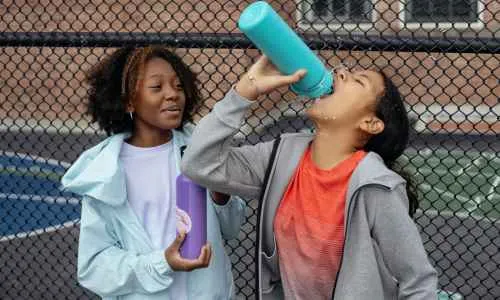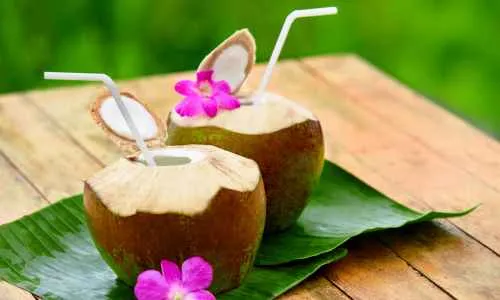Learn how to accurately calculate the optimal intake of water for pickleball players with our comprehensive guide. Improve your game and stay hydrated.
Summer offers the perfect backdrop for pickleball, extending your playtime with longer daylight and warm evenings. However, the summer heat can pose challenges, particularly with increased sweating.
In warmer conditions, your body loses more water to maintain a stable core temperature during physical activity. This heightened effort leads to increased water loss. A recent Physiology and Thermal Regulation study notes, “During intense exercise, the body’s temperature can temporarily spike to levels as high as 40°C or 104°F.” Consequently, the risk of overheating and heatstroke rises, especially during outdoor pickleball matches under the direct sun.
How much water should you drink to keep safe in the summer sun, avoid dehydration, and enjoy your favorite sport to perform these tasks?
There is no specific quantity for everyone. Hydration demands vary by age, weight, exercise level, play length, and other factors. However, well-researched guidelines can help determine how much water you must bring to court for hydration.
Table of Contents
Calculating How Much Need Water for Pickleball Players
The conventional recommendation of consuming “6-8 glasses of water per day” lacks precision as it disregards a critical factor: body weight. Weight plays a substantial role in establishing an individual’s water needs.
Maintaining proper hydration is paramount when you’re engaged in active pursuits like intense pickleball matches. As per direction from the American School of Sports Medication, consider drinking 12 extra ounces of water for each half-hour of activity. It helps to replace the fluids from your body through sweat while in the game, keeping you feeling your best. So remember, when you play hard, drink up!
To determine your daily water requirement solely based on your weight, without taking your activity level into account, you can employ this formula: Multiply your body weight in pounds by 0.5, and you’ll have the daily amount of water you should aim to consume, measured in ounces.
For an individual’s weight in pounds (W):
- If W = 140 lbs, the calculation is: W x 0.5 = 140 x 0.5 = 70 ounces.
- If W = 190 lbs, the calculation is: W x 0.5 = 190 x 0.5 = 95 ounces.
So, in general terms:
For an individual weighing W pounds, the baseline water requirement can be calculated as:
W x 0.5 = 0.5W ounces.
Example 1:
- Duration of pickleball session: 60 minutes
- Weight: 140 pounds
Baseline water requirement based on body weight: 140 pounds x 0.5 = 70 ounces. Additional hydration for the 60-minute exercise session: 24 ounces (12 ounces every 30 minutes).
Total water requirement: 70 ounces (baseline) + 24 ounces (exercise) = 94 ounces.
| Description | Calculation | Total Water Requirement |
| Weight | 140 pounds | |
| Duration of Pickleball Session | 60 minutes | |
| Baseline Water Requirement (Body Weight x 0.5) | 140 pounds x 0.5 = 70 ounces | 70 ounces |
| Additional Hydration for Exercise | 12 ounces every 30 minutes (60 mins) | 24 ounces |
| Total Water Requirement | 94 ounces |
Example 2:
- Weight: 190 pounds
- Duration of pickleball session: 90 minutes
Baseline water requirement based on body weight: 190 pounds x 0.5 = 95 ounces. Additional hydration for the 90-minute exercise session: 36 ounces (12 ounces every 30 minutes, three intervals).
Total water requirement: 95 ounces (baseline) + 36 ounces (exercise) = 131 ounces.
| Description | Calculation | Total Water Requirement |
| Weight | 190 pounds | |
| Duration of Pickleball Session | 90 minutes | |
| Baseline Water Requirement (Body Weight x 0.5) | 190 pounds x 0.5 = 95 ounces | 95 ounces |
| Additional Hydration for Exercise | 12 ounces every 30 minutes (90 mins) | 36 ounces |
| Total Water Requirement | 131 ounces |
So, in summary:
- For a 140-pound person playing pickleball for 60 minutes: 94 ounces of water needed.
- For a 190-pound person playing pickleball for 90 minutes: 131 ounces of water needed
It’s crucial to consider your activity level after determining your baseline water requirements based on your body weight. For athletes and pickleball enthusiasts who love to stay active, staying hydrated is like fueling your body’s engine.

- Mastering the Explosive Pickleball Serve (Insane power + spin)
- How to prevent pickleball injuries
- World’s Highest Pickleball Court Returns to Dallas In July
- Adopting the Open Stance Pickleball Serve
- UPA-A launches professional paddle certification program
Special Considerations For Adjusting Fluid Levels
It’s essential to consider various factors when adjusting fluid levels to ensure proper hydration. Here are some key considerations and additional tips:
Here are some more hydration advice and things to think about, such as some particulars for athletes who are breastfeeding or pregnant, as well as factors to remember like room temperature and caffeine intake:
Pregnancy and Breastfeeding: Pregnant or breastfeeding athletes should drink an extra 24 to 32 ounces (about 710 to 946 ml) of water daily to maintain proper hydration. These life stages often require increased fluid intake to support the body’s additional demands.
Environmental Temperature: The environmental temperature plays a significant role in your hydration needs. On scorching days, you may lose more fluids through sweat, necessitating increased water intake to compensate for this additional sweat loss.
Urine Color as a Hydration Indicator: Monitoring the color of your urine throughout the day is an effective way to gauge your hydration level. Ideally, your urine should appear clear or pale yellow. If your urine darkens in color, it’s a sign to increase water intake to maintain proper hydration.
2. Caffeine Awareness
For those primarily consuming caffeinated beverages, be mindful of caffeine’s diuretic effects, which can increase urine production and potential fluid loss. Adjust your water intake accordingly.
3. Tailoring Hydration to Specific Circumstances
Consider your unique circumstances and adapt your hydration practices, whether you are an athlete, pregnant, or dealing with varying environmental conditions and beverage choices.
4. Age-Related Hydration Concerns
Both older adults and children are more susceptible to dehydration and should pay extra attention to their fluid intake to ensure they drink enough fluids.
5. Hydration and Medical Conditions
Individuals with specific medical conditions like kidney disease, heart disease, and diabetes must be cautious about their fluid intake and consult their healthcare provider for guidance.
6. Medication Impacts on Hydration
Certain medications can lead to dehydration, so carefully read labels and discuss concerns with a healthcare professional.
7. General Hydration Tips
Drink water throughout the day, aiming for at least eight glasses daily, with adjustments for physical activity and hot climates.
8. Specific Population Hydration Recommendations
For Athletes: Hydrate before, during, and after exercise to replace fluids and electrolytes lost through sweat.
For People with Kidney Disease: Monitor fluid intake due to potential difficulties in filtering excess fluid.
For People with Heart Disease: Limit fluid intake to prevent fluid accumulation in the lungs.
For People with Diabetes: Consume adequate fluids while managing sugar intake to prevent dehydration. Consulting a healthcare provider can help determine the best fluid choices.
9. Consult with Your Doctor
It is best to contact your doctor if you need more information on optimal hydration consumption. They can build a customized hydration strategy that focuses on your needs and guarantees you stay hydrated.

How to Maintain Proper Level of Water for Pickleball Players on the court
Pickleball is a fun and active sport, but staying hydrated is crucial, especially when it’s hot. When you play pickleball and sweat, you lose water from your body. If you don’t replace this lost water, it can affect your performance and health. Here’s a straightforward guide on how to stay hydrated when playing pickleball:
Pre-Hydrate: Start hydrating before you step onto the court. Drink water in the hours leading up to your game to ensure you begin well-hydrated.
Bring a Water Bottle: Always have a water bottle on the court. It’s essential for easy access to fluids during breaks and between points.
Electrolyte Balance: Besides water, consider replenishing electrolytes lost through sweat, especially during longer matches. Sports drinks or electrolyte supplements can help maintain your electrolyte balance.
Shady Breaks: Take short breaks in the shade between games or sets to cool down and rehydrate.
Monitor Sweat Rate: Pay attention to your body’s cues. If you’re sweating heavily, you’re losing fluids rapidly, and you’ll need to drink more to compensate.
Wear Breathable Clothing: Choose lightweight and moisture-wicking clothing to help your body stay cool and reduce sweating.
Avoid Alcohol and Caffeine: These beverages can contribute to dehydration, so limiting or avoiding them before and during your game is best.
Fruits and Snacks: Bring hydrating snacks like water-rich fruits (e.g., watermelon, oranges) to nibble on during breaks.
Know Your Personal Needs: Remember that individual hydration requirements can vary. Factors like body weight, sweat rate, and the duration and intensity of your game should all be considered.
Listen to Your Body: If you experience dizziness, fatigue, or signs of heat-related issues (such as nausea or a rapid heartbeat), stop playing, find shade, and drink water.
Pre-Game Preparation
Pre-hydration: Take 17-20 ounces (around 500-600 ml) of Water 2-3 hours before your game to guarantee you start hydrated enough.
Warm-up Hydration: Drink an extra 8 ounces (around 240 ml) of water during your get-ready to set up your body for actual work.
During Your Match
Regular Hydration: Aim to drink 7-10 ounces (about 210-300 ml) of water between games and repeat this every 10-20 minutes during play to maintain hydration.
Consider Sports Drinks: For matches lasting over an hour, consider using sports drinks instead of plain water. Sports drinks contain electrolytes that aid fluid absorption.
Post-Match Recovery:
Immediate Rehydration: Your hydration efforts shouldn’t end when the match does. Within 30 minutes of completing your round, aim to consume 8 ounces (about 240 ml) of water. This quick rehydration jump-starts your body’s recovery process, helping to replace the fluids lost during intense play.
Continuous Hydration: Hydration is not a one-time task. Drink fluids throughout the day to ensure you entirely replace the fluids lost during your match. Pay attention to your body’s cues – if you’re urinating frequently and it’s pale yellow, you’re likely well-hydrated.
Playing in Hot Weather:
Appropriate Attire: Choose your attire wisely when playing in hot weather. Opt for loose-fitting, light-colored clothing that allows your body to breathe and helps regulate your temperature. It can considerably minimize sweating and overheating.
Sun Protection: Protect yourself from the sun’s rays by wearing a hat and applying sunscreen. Sunburn can not only be uncomfortable but can also contribute to dehydration.
Take Breaks: During longer matches or matches played in scorching heat, seek shade or air conditioning during breaks. These short breaks provide a crucial opportunity to cool down and rehydrate.
Timing Matters: Avoid scheduling matches during the hottest part of the day, typically from late morning to early afternoon. Playing in moderate temperature hours can significantly affect your comfort and performance.
What Are Electrolytes?
Maintaining electrolyte balance is essential for overall health and is particularly important when engaging in physical activities like pickleball, especially in hot weather.
Keeping up with the proper equilibrium of electrolytes isn’t only significant for your general prosperity. Still, it can affect your exhibition, particularly during proactive tasks like pickleball, mainly when it’s hot outside. Here is a manual to assist you with dealing with your electrolytes successfully:
1. Remain Hydrated: Keeping yourself hydrated is the establishment for keeping a decent electrolyte balance. Regularly drink enough water over the day, particularly when you’re dynamic or in hot circumstances. Water ought to be your essential decision to remain hydrated.
2. Consume a Reasonable Eating routine: A balanced eating regimen incorporating various food varieties can give you the fundamental electrolytes your body needs. Food varieties are rich in electrolytes, including potassium in bananas and oranges, calcium in dairy items, and magnesium in mixed greens and nuts.
3. Choose Electrolyte-Rich Food sources: Different varieties of food typically contain high electrolytes in your dinners and bites. For example, you can nibble on a banana or snatch some nuts before a game.
5. Coconut Water: Consider normal coconut water if you are inclined toward regular other options. It’s an extraordinary wellspring of potassium and can be a refreshing decision to reestablish your electrolyte balance.

6. Electrolyte Enhancements: A few competitors go to electrolyte enhancements or tablets that can be added to water. These enhancements offer an exact method for guaranteeing you’re keeping up with your electrolyte balance precisely.
Tips for maintaining healthy electrolyte levels:
Adjusting your electrolytes is essential, particularly if you’re dynamic or live in a warm environment. Here are a few valuable hints to assist you with keeping up with the right electrolyte balance:
1. Keep a Reasonable Eating regimen: Guarantee balanced eating that remembers various food sources rich in electrolytes, like natural products, vegetables, entire grains, and nuts.
2. Remain Enough Hydrated: Mean to consume adequate liquids every day. The overall suggestion for grown-ups is around 15.5 cups (3.7 liters) of fluids daily, But this may change if you’re active or in a hot climate.
3. Pick Electrolyte-Containing Beverages: Select refreshments containing electrolytes, particularly when dynamic or post-workout. You can choose from sports drinks, electrolyte powders, or everyday choices like coconut water.
4. Renew After Active work: Following extreme proactive tasks that result in critical perspiring, renew lost electrolytes with sports drinks, powders, or coconut water.
5. Perceive Irregularity Signs: Dive more deeply into the indications of electrolyte imbalance, including muscle cramps, weariness, cerebral pains, and sickness. If you experience any of these side effects, enjoy some time off and zero in on liquid admission until you feel quite a bit improved.
Extra Tips:
Moderate Liquor Use: Extreme liquor utilization can prompt drying out and upset your body’s electrolyte balance. Be aware of your liquor utilization, particularly before or after proactive tasks.
Limit Caffeine: Like liquor, caffeine can increase dehydration and affect electrolyte levels. Consume juiced drinks with some restraint, particularly when you’re dynamic.
Counsel an Expert: If you have different kinds of feedback about your electrolyte balance, it’s fitting to converse with your primary care physician or an enlisted dietitian. They can offer customized appeal given your novel well-being and action levels.
By observing these rules and being sensitive to your body’s signs, you can maintain a legitimate electrolyte balance, support your general well-being, and perform at your best during exercises like pickleball.
conclusion
Proper hydration is crucial for pickleball players to perform at their best and maintain their overall health on the court. As highlighted in the examples provided, an individual’s water requirements are influenced by factors such as body weight and the duration of the game.

